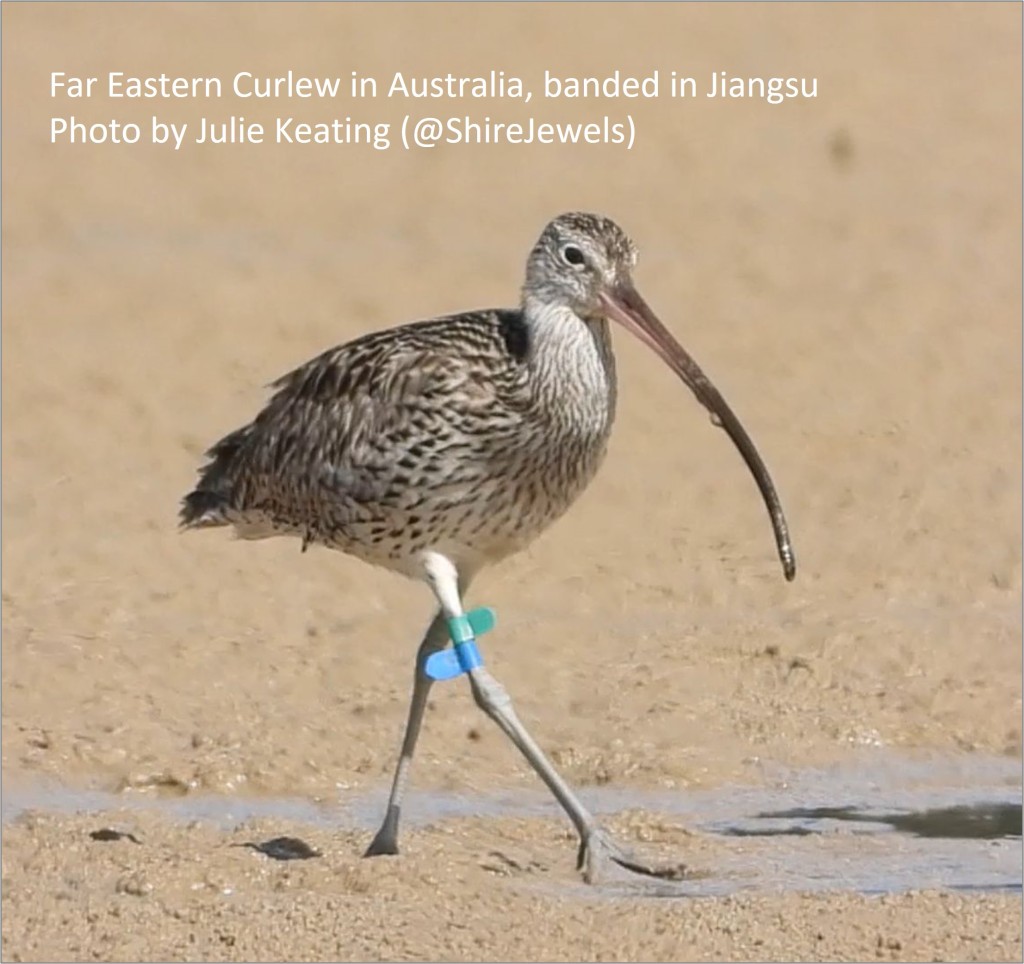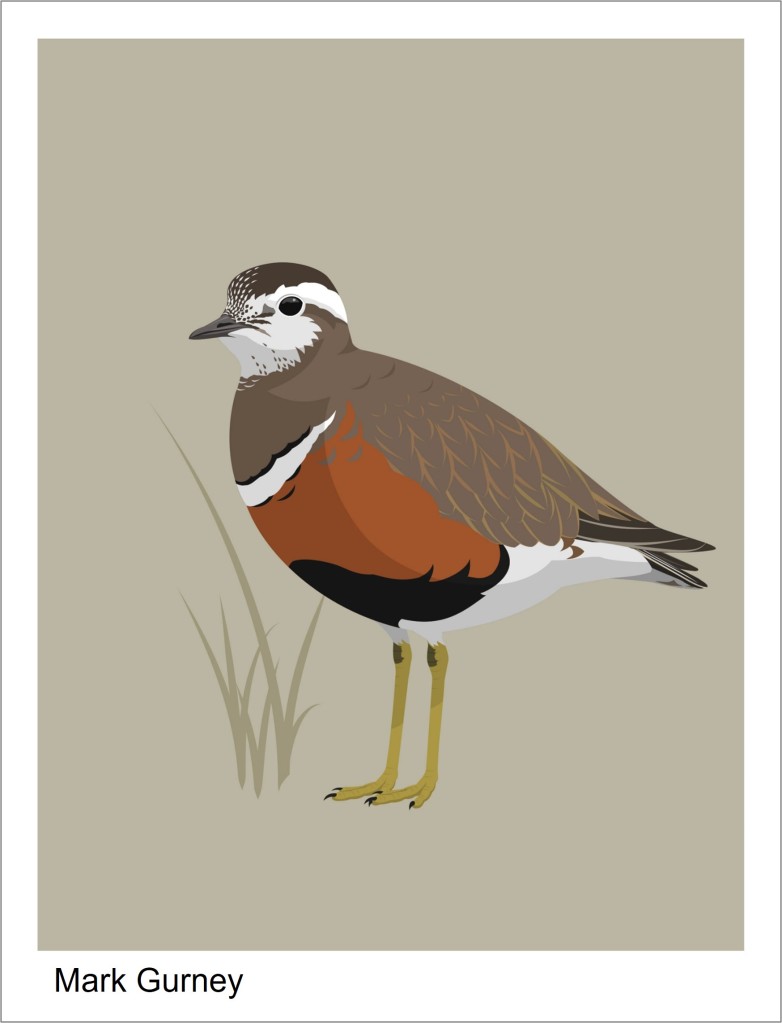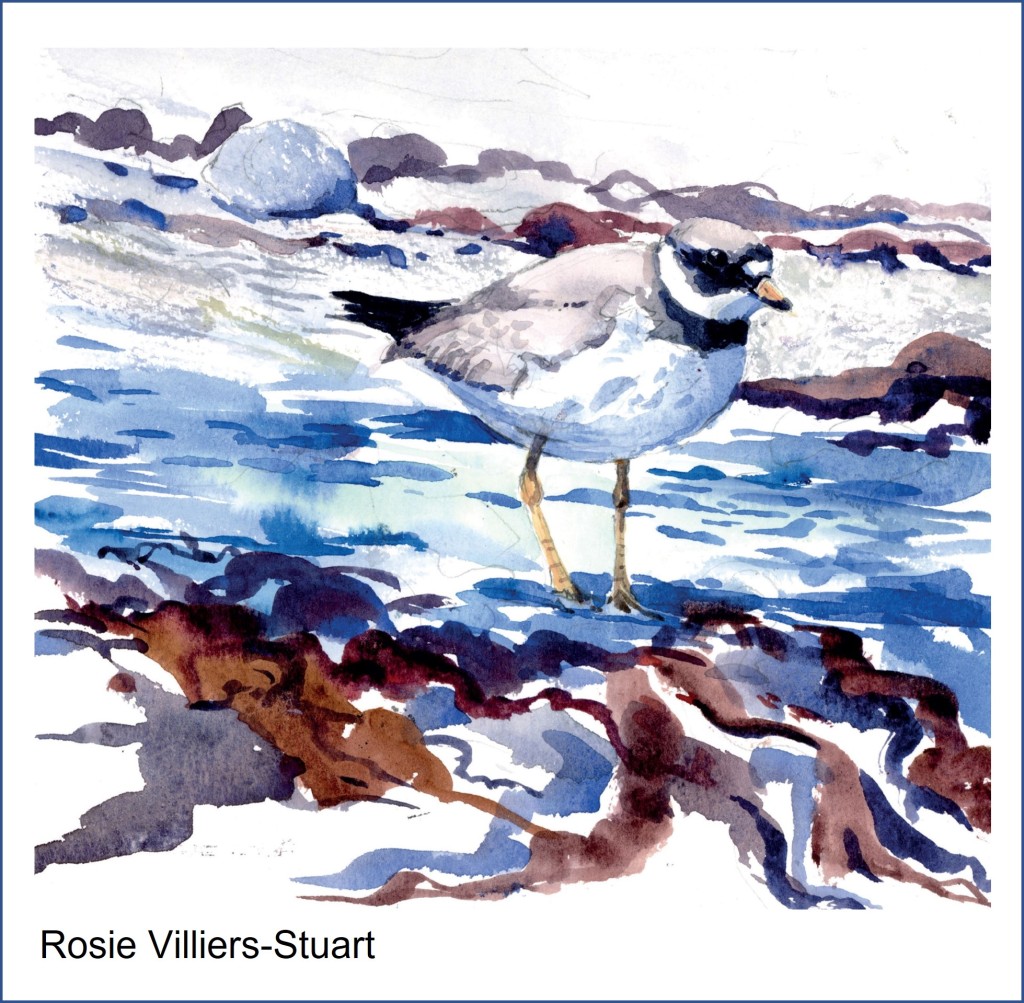The Yellow Sea provides important ‘service stations’ for shorebirds on the East Asian-Australasian Flyway, especially on their way north to Russian and Alaskan breeding areas. In a thought-provoking paper in Biological Conservation, Xiaodan Wang and colleagues consider how assemblages of waders have changed, as available habitat has been lost on this flyway. Their results suggest that conservation of these migratory shorebirds will depend upon lots of local initiatives.
The Yellow Sea
As discussed in Wader declines in the shrinking Yellow Sea, based on a paper by Colin Studds et al, the number of shorebirds on the East Asian-Australasian Flyway (EAAF) has fallen significantly. The rapid decline has been linked to a sudden drop in the survival rates of adults, especially in Bar-tailed Godwit, Red Knot and Great Knot. For these three species, the proportion of adults dying each year doubled over a period of just three years, with a strong link between species’ dependence upon the Yellow Sea and the rate of decline in numbers. This study and other papers have spawned welcome conservation initiatives and collaborative research programmes in China, South Korea and the Democratic People’s Republic of Korea.

In the most recent appraisal of numbers for EAAF shorebird species that travel as far as Australia, it is estimated that the number of Far Eastern Curlew has dropped to just 35,000 individuals and that there was a 50% drop in numbers for Curlew Sandpiper and Red Knot between assessments in 2008 and 2021. These catastrophic changes show how quickly things can go wrong, especially when adults struggle to get through the annual breed-migrate-moult-fatten-migrate cycle.
In their paper, Xiaodan Wang et al compared the results of shorebird surveys on the Yellow Sea coast of China during northwards migration, between an “early” study period (1996 to 2005) and a “late” study period (2013 to 2014), at 14 stop-over sites. These are sites where large areas of tidal habitat have been destroyed.

What happened?
In their study, the authors investigated three hypotheses:
- Are trends in population numbers at stopover sites (in China) similar to those detected in nonbreeding sites (e.g. Australia)?
- Is the diversity within shorebird communities linked to habitat condition?
- How does a reduction in the area of tidal habitat affect numbers of waders and the composition of shorebird communities?

Counting shorebirds
China’s Yellow Sea region, which extends from the Yalu Estuary (Liaoning Province) in the north, to the Yangtze Estuary (Shanghai) in the south, holds the largest areas of intertidal mudflats in the world. The first comprehensive spring shorebird surveys along this Yellow Sea coast were conducted between 1996 and 2005 (the early period in this study). The Yellow Sea coast was surveyed again in 2013 and 2014 (the late period), by which time large areas of several intertidal flats had been ‘claimed’ and turned into farmland and industrial zones. See paper for methods.
A total of 14 sites were surveyed at similar times, in the early and late periods, enabling comparisons of community richness, the abundance levels of individual species and the density of birds across the available feeding habitat. The key results of the study are:
Counts: The measured decline in bird numbers was on a scale which was less dramatic than those reported from Australia. At the 14 stopover sites, a total of 668,995 individuals of 44 species were recorded in the early period, and a total of 617,146 individuals of 43 species were recorded in the late period. This corresponds to a 7.8% reduction between the early and the late periods.
Species richness: There was much variation between sites, with between 18 and 38 shorebird species recorded, but the numbers of species on each study site were similar between the two periods.

Distributions: Decreased abundance was recorded at ten sites and increased abundance was recorded at four sites. The number of birds on the Liaohe Estuary trebled between the early and late periods, mostly due to the discovery of a flock of 80,000 Great Knot. A recent population assessment of shorebirds of the East Asian-Australasian Flyway suggests that this large flock accounts for 20% of the world’s Great Knot. These passage flocks of Great Knot tend to stay for only a few days, making it hard to reliably pick up any changes between years.
Change across the region: No significant differences were found in species richness or abundance at the same sites, between the periods, but there were significant differences among sites. Ten species were recorded in smaller numbers, with increases for Bar-tailed Godwit (up 16.8%) and Great Knot (57%).
Communities: Bird assemblages at each site were similar in the two study periods, with the commonest species remaining the same. For example, Great Knot and Bar-tailed Godwit are the dominant species in the Yalu Estuary, while Red Knot and Curlew Sandpiper are the dominant species in North Bohai Bay, in both periods.
Loss of habitat: The total tidal flat area decreased by 35.6%, from 4017 km2 in the early period to 2588 km2 in the late period. Habitat loss was detected at all of the 14 sites. More than half of the tidal flat was destroyed at Northern Bohai Bay, Laizhou Bay, Southwest Bohai Bay, and Jinzhou. Relatively small losses (< 10%) occurred at Chongming Dongtan, Yalu Estuary, Jiaozhou Bay, and Liaohe Estuary (see map).
Shorebird densities: Shorebird densities (birds per km2 of mudflat) differed markedly between sites. During the study period, the estimated bird density increased at 7 sites and decreased at 5 sites, with an overall increase in density of over 40% between the early (1996-2005) and late (2013-2014) periods.

Bit of a squeeze?
‘Land claim’ – turning mud flats into farmland and industrial areas – reduced the amount of available feeding habitat in the Yellow Sea study area by 35% between 1996-2005 and 2013-2014. If the same numbers of waders were to be accommodated, then that would imply increases in densities of about 55%. This assumes that feeding conditions remain the same and that spring fattening can happen just as quickly, despite the higher densities. If it’s harder to find food, birds will potentially need to stay longer, to fatten up for the next part of their migration, and that suggests that densities would need to be even higher. The observed change in density of 40% is lower than 55% but this may be consistent with falling populations.

What might be happening?
It is clear that wader numbers in the Yellow Sea have declined, as expected from annual counts in Australia and New Zealand. However, the decline in spring numbers is not as dramatic as might have been predicted. The remaining birds have much less space in which to feed and densities have increased, suggesting that there will be more competition for resources than there was a decade previously. Returning to the three hypotheses put forward by the authors:
Are trends in population numbers at stopover sites (in China) similar to those detected in nonbreeding sites?
Bird surveys covered the same zones and were conducted on similar dates in the early and late periods. Changes in shorebird counts during the study periods did not always exhibit the same population trends as those at nonbreeding sites in Australia and New Zealand.
Is the diversity within shorebird communities linked to habitat condition?
The fact that there are different mixes of waders on different estuaries is probably linked to different food resources. It would be good to know more about the food that is available to species as diverse as small sandpipers and large curlew – especially in the earlier period before so much habitat was lost. Red Knot and Great Knot give hints that waders are found on sites that are appropriate to their needs, with more Great Knot on Yalu Estuary, where the key shellfish they eat (Potamocorbula laevis) are larger, and more Red Knot at Nanpu, where the shellfish are smaller. Given the expected links to available feeding opportunities on individual sites, it is unsurprising that the diversity of shorebird communities has tended to remain the same.
How strong is the link between the change in the area of tidal habitat lost and the changes in the numbers of waders and the composition of shorebird communities?
The research team expected to find changes in shorebird numbers and species composition but the relationships are not as strong as might have been expected, given the areas of mudflat that have been lost.
There is no clear pattern of community change, as just discussed, and this is in line with analyses of more comprehensive annual Wetland Bird Survey data, collected in the United Kingdom. As population levels fell, the changes were spread across all estuaries. Some people may have predicted that distributions would have become more focused on ‘better’ estuaries but this was not the case for wintering waders. Ringing studies suggest that individuals’ site-fidelity is strong, which reduces the potential for distributional change. This study is described in the WaderTales blog, Interpreting changing wader counts, which summarises a paper in Diversity & Distributions, by Méndez et al.
In the Studds paper, there is a clear signal that species that are more dependent on the Yellow Sea exhibited the steepest declines in numbers, so it seems unlikely that there was an excess of available food at the time of the first surveys (1996-2005). If food supplies are limiting, why is the link between habitat lost and numbers not stronger?

Xiaodan Wang et al discuss why they did not see a clearer relationship between mudflat loss and changes in shorebird numbers. They suggest that population declines may be less severe in some (or even all) of the study sites than might have been expected because these are known hot-spots for waders. Losses may have been more dramatic elsewhere. We know that severe habitat loss can remove most waders from a site, leading to redistribution of affected birds.
It is also possible that individual birds could be staying longer at spring staging sites in the Yellow Sea, due to poorer feeding conditions or changes to the timing of migration. This build-up of birds could mask the scale of the real declines in numbers using Yellow Sea mudflats. In the future, information gleaned from tracking and through resightings of colour-ringed birds should help to monitor stop-over times. Sadly, similar data are not available for the period 1996 to 2005.
Conservation Implications
This paper provides another reminder that structured surveys are immensely valuable. Back in 1996, could anyone have imagined how quickly China’s Yellow Sea mudflats would be turned into farmland and industrial complexes? Extending surveys to more estuaries in the East Asian-Australasian Flyway, using standardized protocols and sharing datasets, will be important, when assessing responses to habitat changes at breeding, stopover, and nonbreeding sites.
Studies at the species level, especially those focused on habitat specialists, have found that some birds cannot successfully relocate to alternate sites if their major staging sites are lost (e.g., Moores et al. 2016). This paper, by Xiaodan Wang et al, concludes that maintaining populations of migratory species along the East Asian-Australasian flyway depends upon the conservation of an extensive network of estuaries within the Yellow Sea.
Paper
The full paper can be accessed here:
Impacts of habitat loss on migratory shorebird populations and communities at stopover sites in the Yellow Sea. Xiaodan Wang, Ying Chen, David S.Melville, Chi-Yeung Choi, Kun Tan, Jiajia Liu, Jing Li, Shoudong Zhang, Lei Cao & Zhijun Ma. Biological Conservation.

WaderTales blogs are written by Graham Appleton (@GrahamFAppleton) to celebrate waders and wader research. Many of the articles are based on published papers, with the aim of making shorebird science available to a broader audience.


















